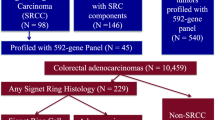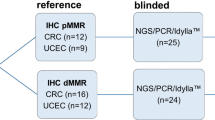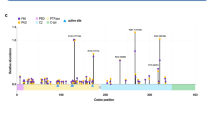Abstract
Immunocytochemistry (ICC) has been used routinely to stain for p53 overexpression in a range of human tumours. The underlying assumption has been that positive staining indicates a mutation in the p53 coding sequence. Recently, however, discordancy has been observed and the accuracy of ICC as a marker of p53 gene mutation has been questioned. In this study of 109 colorectal adenocarcinomas, we compared ICC staining with p53 gene mutations detected by single-strand conformation polymorphism (SSCP) analysis. Concordancy between the two techniques was found in 69% of tumours. ICC-positive/SSCP-negative cases accounted for 20% of tumours and ICC-negative/SSCP-positive cases for the remaining 11%. These results caution against the assumption that p53 protein overexpression is always associated with a gene mutation. Epigenetic phenomena may account for a significant proportion of ICC-positive tumours.
This is a preview of subscription content, access via your institution
Access options
Subscribe to this journal
Receive 24 print issues and online access
$259.00 per year
only $10.79 per issue
Buy this article
- Purchase on Springer Link
- Instant access to full article PDF
Prices may be subject to local taxes which are calculated during checkout
Similar content being viewed by others
Author information
Authors and Affiliations
Rights and permissions
About this article
Cite this article
Dix, B., Robbins, P., Carrello, S. et al. Comparison of p53 gene mutation and protein overexpression in colorectal carcinomas. Br J Cancer 70, 585–590 (1994). https://doi.org/10.1038/bjc.1994.355
Issue Date:
DOI: https://doi.org/10.1038/bjc.1994.355
This article is cited by
-
Understanding genomics and the immune environment of penile cancer to improve therapy
Nature Reviews Urology (2020)
-
Implication of K-ras and p53 in colorectal cancer carcinogenesis in Tunisian population cohort
Tumor Biology (2014)
-
Alterations in K-ras, APC and p53-multiple genetic pathway in colorectal cancer among Indians
Tumor Biology (2013)
-
Activity (transcription) of the genes for MLH1, MSH2 and p53 in sporadic colorectal tumours with micro-satellite instability
British Journal of Cancer (2004)
-
Extent of Nodal Involvement in Stage III Colorectal Carcinoma
Diseases of the Colon & Rectum (2002)



